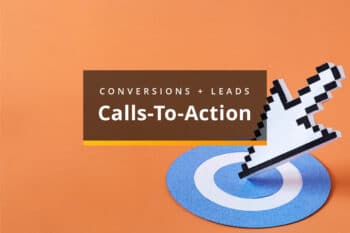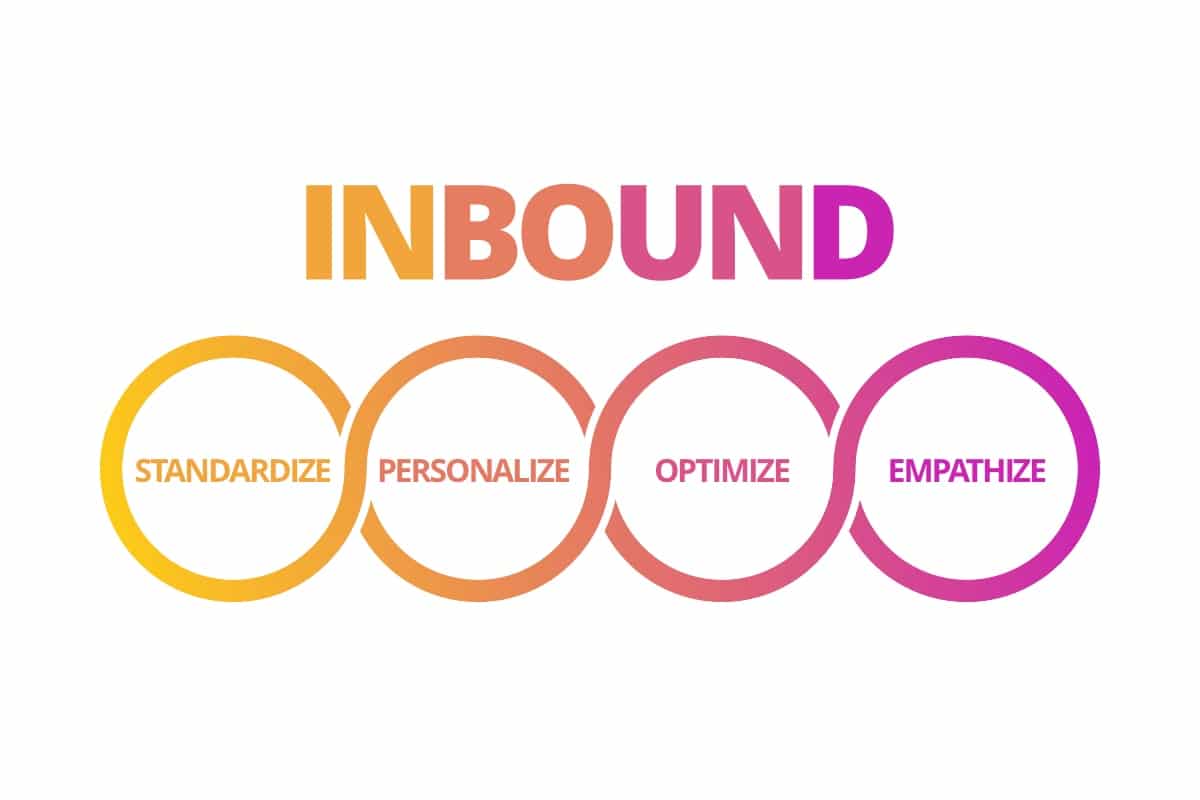
A deep understanding of inbound marketing can go a long way toward helping you get great results. The more you know about the process you are using to bring in new leads (in this case, inbound marketing) the more success you will have designing systems that will lead to desirable outcomes.
To help you get the most from your inbound marketing work, we’d like to take some time in this article to break down the four core principles of this method: standardize, personalize, optimize and empathize. We’ll go through them one by one and we hope you’ll come away with an enhanced understanding of inbound methodology.
Inbound Principle #1: Standardize
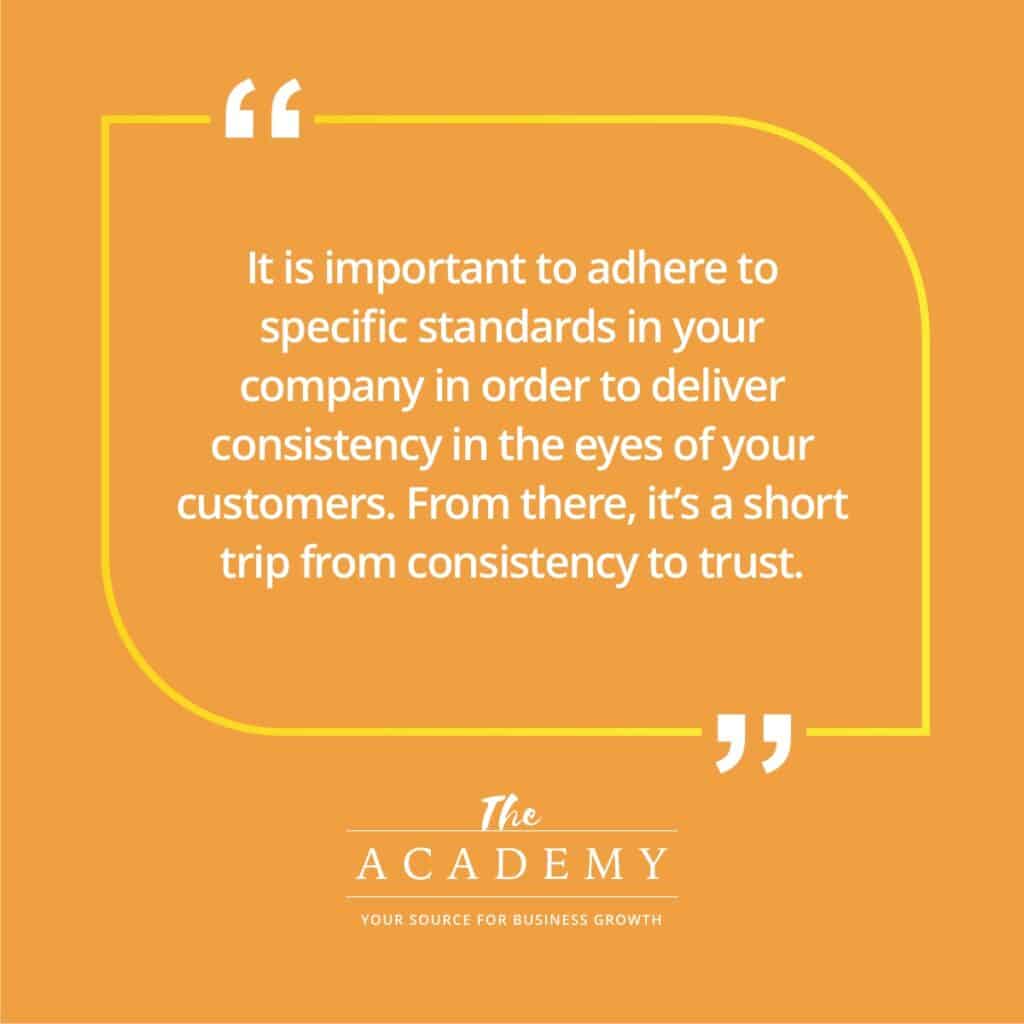
As you start to build up a solid foundation for your inbound marketing efforts, the first principle to understand is standardization. It is important to adhere to specific standards in your company in order to deliver consistency in the eyes of your customers. From there, it’s a short trip from consistency to trust. When someone sees your brand, or your organization, as something that provides a consistent message and offers consistent results, it will be far easier for that individual to trust what you have to say.
Standardization can come into play in many different areas as you interface with both current and potential customers. A couple of those areas include the following:
- Support. When someone reaches out to you for information or clarification on a question, the answer that person gets should be the same from one instance to the next. If there is any variance in your messaging to customers, that could open up gaps that may eat away at any trust you have earned. Why would someone trust your business if they get a different answer each time they need help? Getting organized internally so you can present the same responses to similar queries over and over again is a big boost to standardization.
- Pricing. This is a big one that can lead to a lot of difficult questions if you don’t have a consistent approach. Of course, it’s fine to offer periodic sales or other promotions, but there should be a general level of standardization that runs through your pricing for products and services. This is particularly important if you sell expensive goods for hundreds or thousands of dollars. Customers or clients are going to want to know why they are paying more than someone else if they see that pricing has varied dramatically, and you’ll need to have a good answer to those questions.
You can think about standardization this way… You want to avoid having to answer difficult questions from customers or clients about why things aren’t consistent within your organization. Putting yourself in the customer’s shoes, it’s easy to understand the importance of standardization in communication. You’ll want to hear the same thing time after time, no matter who you are speaking to in an organization. If that isn’t the case, you might start to have some doubts as to whether you should trust this business with your money.
Let’s walk through a quick example to further highlight how this works. Imagine that your organization sells a service that clients pay thousands of dollars to purchase. As a prospective client works through the sales funnel, they may call in a few different times to ask questions and make sure your service is right for their needs. In one call, they speak with a member of your team who answers a specific question about the timing of how your services are delivered. Later, in another phone call with a different team member, the same question comes up – and a different answer is provided.
What now? The client is left confused and wondering if your business is disorganized at best or untruthful at worst. Either way, they aren’t going to be impressed, and it’s far less likely that you’ll close the sale. By having tools in place like product info sheets and other reference materials that standardize your messaging, these errors will be less likely to occur.
Inbound Principle #2: Personalize
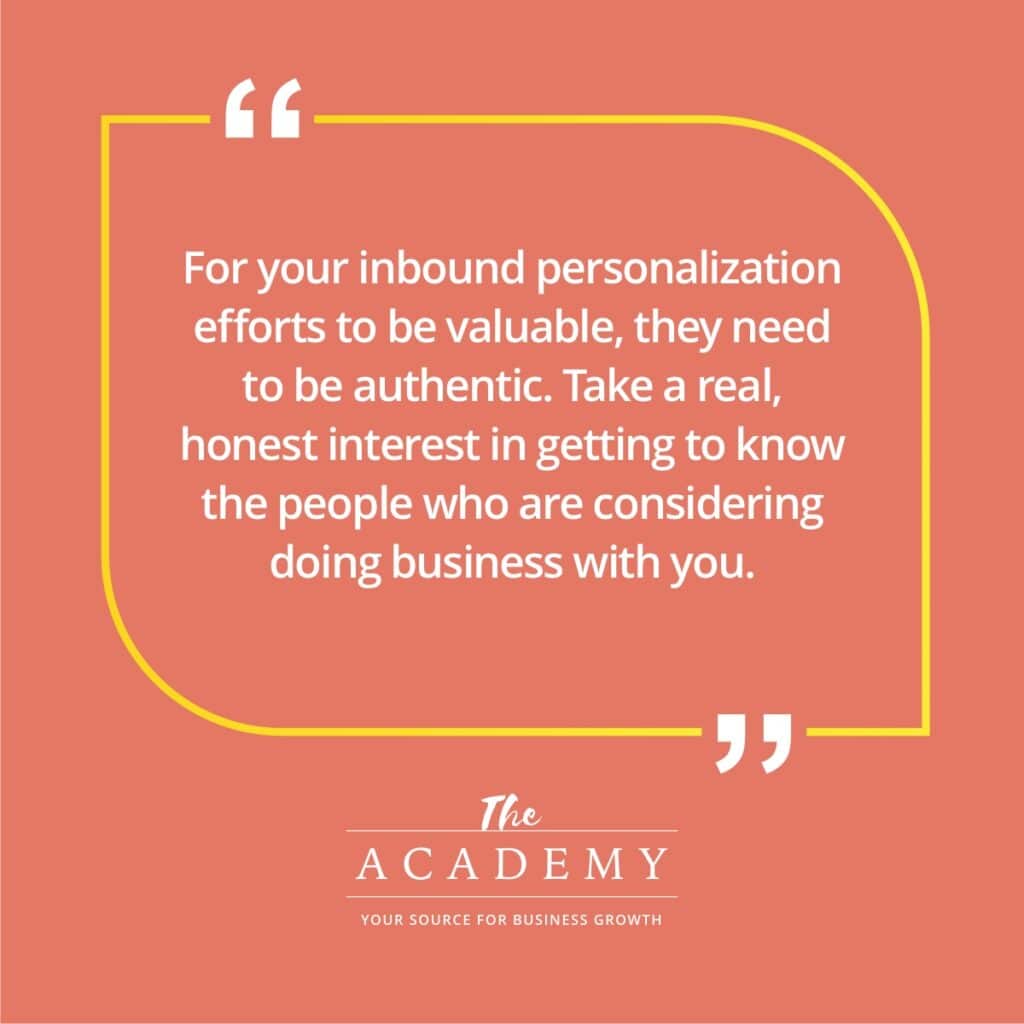
Personalization is a big part of what inbound marketing is and why it is so effective. You are trying to bring people into your organization, one at a time, by building trust and attending to their needs. This doesn’t happen when you take a cold and calculated approach to sales; It happens by being personal, getting to know your prospects and catering to what it is that matters to them.
The value of personalization gets back to the concept of trust that we were talking about above. People tend to trust people that they know, so taking the time necessary to get to know your prospects will go a long way. On the flip side of that coin, it’s hard to build trust when you sound like a robot trying to close a sale. If your inbound efforts are going to be profitable, a commitment to being personal is vital.
It’s worth mentioning that most people can quickly tell the difference between authentic conversation and fluffy sales talk that is only aimed at making a deal. So, for your inbound personalization efforts to be valuable, they need to be authentic. Take a real, honest interest in getting to know the people who are considering doing business with you. Not only is this good marketing, but it can also lead to rewarding relationships that range far beyond the office.
Of course, if you run an organization that uses a large team to interface with customers, you probably won’t be the only person engaging with each prospect. If that is the case, the proper use of a customer management system is key. By making notes in your CMS that reference prior conversations and highlight personal notes about the prospect, everyone in the organization can work to further grow this connection and gain valuable trust.
Inbound Principle #3: Optimize
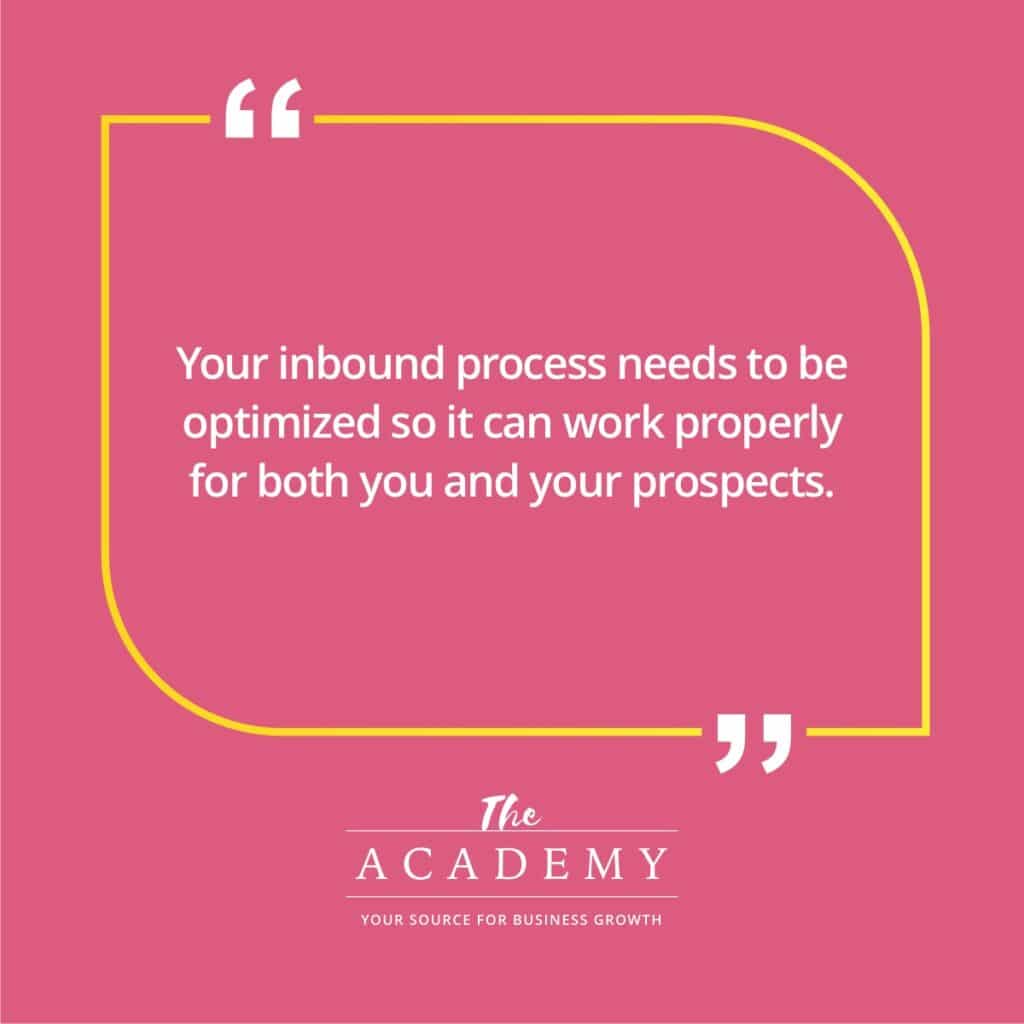
So far, we’ve talked a lot about engaging honestly with your prospects in inbound marketing. You are going to take the time to get to know them personally, and you are going to work hard to standardize your message throughout the entire organization. That’s all important, but you probably can’t afford to be inefficient with those efforts; There just aren’t enough hours in the day to do things that don’t provide a good return on the time invested.
This is where optimization comes into the picture. Your inbound process needs to be optimized so it can work properly for both you and your prospects. A good way to optimize is to pay attention to what communication channels you use for each stage of the buyer’s journey. For example, a means of communication that works great at the top of the funnel may not prove to be efficient as prospects get closer and closer to making a purchase.
Unfortunately, there is no standard guideline for how this should work, as it is going to vary wildly from one organization to the next. Businesses that sell expensive products or services can likely afford to invest more manual time in each lead, sitting on phone calls or video chats for hours at a time, in some cases. However, that doesn’t work for a business selling products for under $100. You’ll need to think about how much time can reasonably be invested into each lead and then tailor your methods of communication to match those limits.
While we can’t tell you precisely how you’ll be able to optimize inbound communication in your business, we can walk through an example below to help you understand the thought process. The points below highlight how a business that sells a product or service in the $1,000 range might go about this point:
- Informational Materials are Available. For leads at the top of the funnel, plenty of informational materials will be made available to answer common questions and keep phone calls to a minimum. The materials could take many different forms, such as short videos, FAQ pages and blog posts. These are things you can make once and use over and over again to help people learn about what you sell without reaching out directly.
- Offer a Range of CTA Options. As a lead moves through the funnel and gets closer to hopefully making a purchase, the options for contacting your organization directly will get easier to find. A sales phone number or email address will be displayed after some of the marketing materials have been consumed, so any lingering questions can be answered and a deal can be closed.
- Utilize Automation to Stay in Touch. In the post-sale process, developing a system to keep in touch with customers without using up valuable labor hours is important. This could be done through a drip email sequence that offers advice on common problems and directs customers to the right places for more help.
As you can see in this setup, the stage right before a prospect may want to make a purchase is when they are directed to use communication channels that give them a person to speak with directly. Otherwise, the focus is on using established informational materials to communicate the message and limit the demands on your team. Of course, if this business sold products or services for $10,000 or $100,000 instead of $1,000, this balance would be different, and direct support channels would be more readily available.
Inbound Principle #4: Empathize
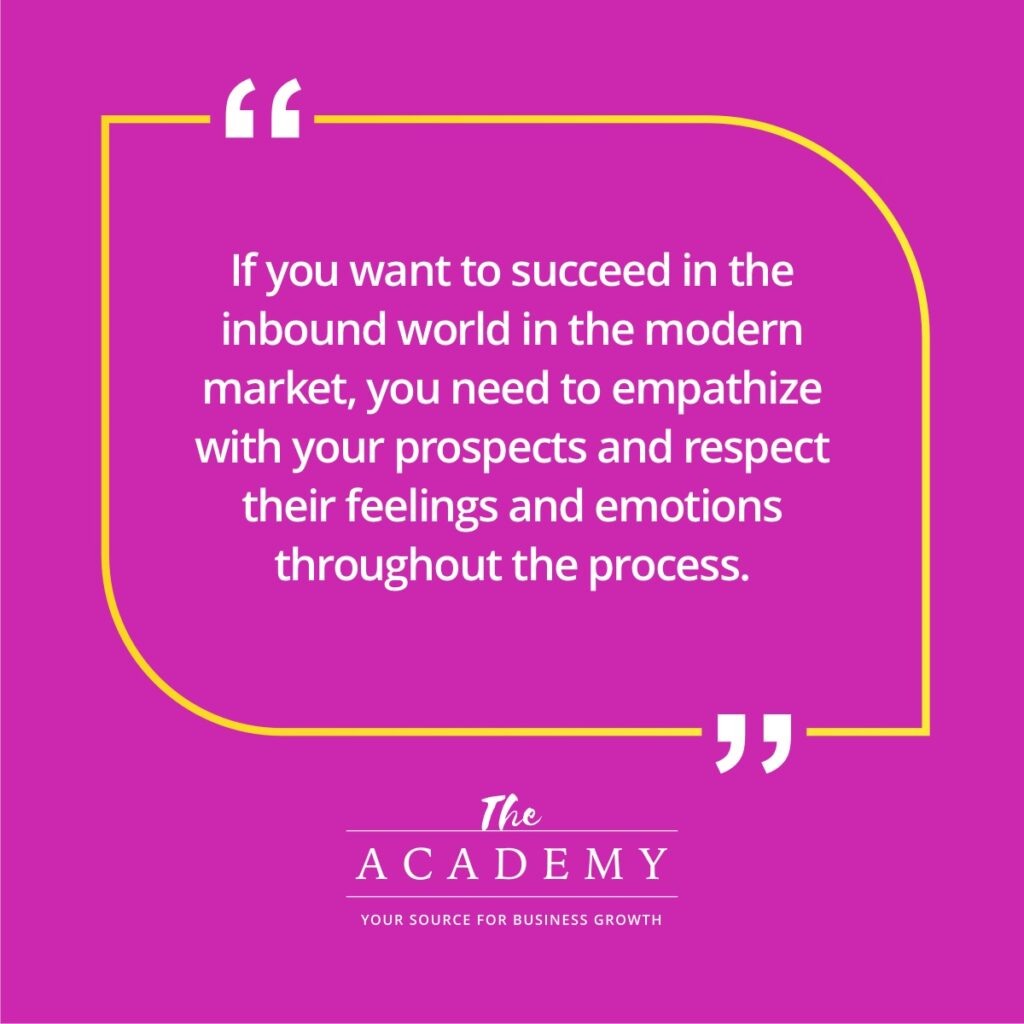
To wrap up, we can’t finish talking about inbound marketing without talking about empathy. Too often, business is treated as nothing but a cutthroat, winner-take-all environment where there is no room for being a real person with real emotions. That might be the way it used to be in many markets, but times have changed. If you want to succeed in the inbound world in the modern market, you need to empathize with your prospects and respect their feelings and emotions throughout the process.
The great thing about adding empathy to your marketing priority list is that it feels good in addition to being effective. It’s hard to operate your business while being cold and calculated for long. Eventually you’ll burn out on taking the hard line and you’ll struggle to draw satisfaction from what you do. By thinking about empathy in addition to growing your business, you can feel more like a human and treat your fellow humans the way they deserve to be treated. Plus, along the way, you’ll gain the respect of countless prospects and your business will likely reach levels that would have been unattainable if you stayed closed off and robotic.
Take the Right Approach to Inbound Marketing
With the right approach to inbound marketing—including attention to standardization, personalization, optimization, and empathy—you can create a powerful process that brings a steady stream of willing prospects into your funnel. Far from aggressive, old-school sales tactics that aim to wear down leads until they make a purchase, you’ll find your prospects are happy to be working with you and deals will be much easier to close. Good luck!
Most Popular Articles

Seeing Favicons in Your Google Search Results? Here’s Why…
Have you noticed anything different in your Google Search results lately? Google added tiny favicon icons to its organic search results in January. It was…

Business Growth and Digital Marketing News & Tips 4-14-24
Did you know? It’s five to twenty-five times more expensive to acquire a new customer than to retain an existing one. Increasing customer retention by…

Business Growth and Digital Marketing News & Tips 3-28-24
With the desire for precise measurement tools to determine ROI, there has been a rise in attention metrics. These metrics, which often utilize eye-tracking data,…


